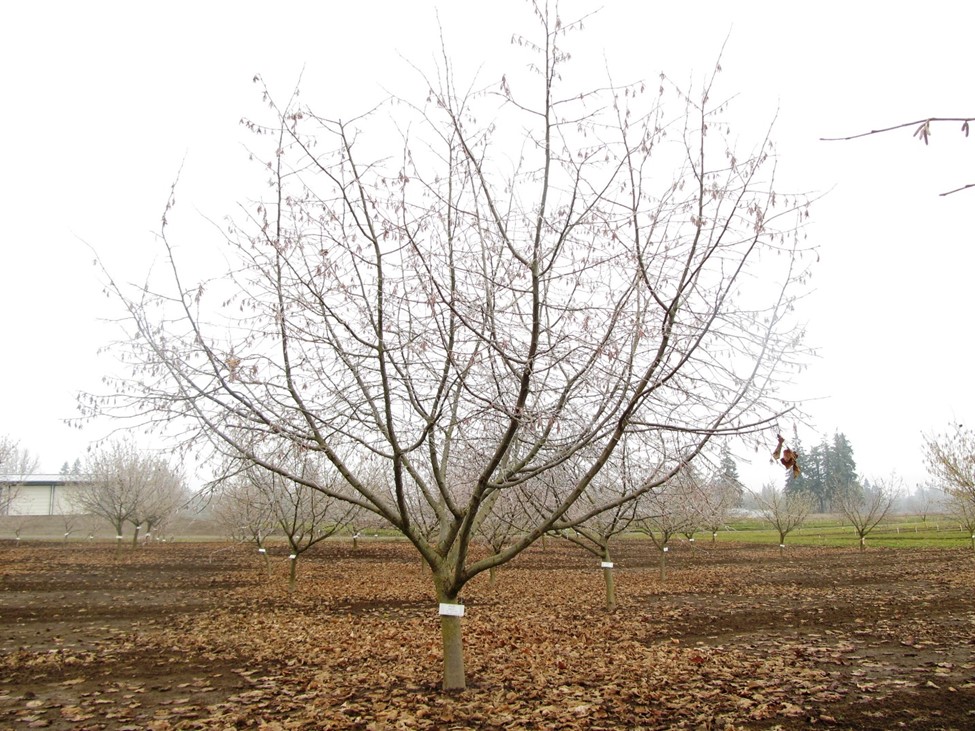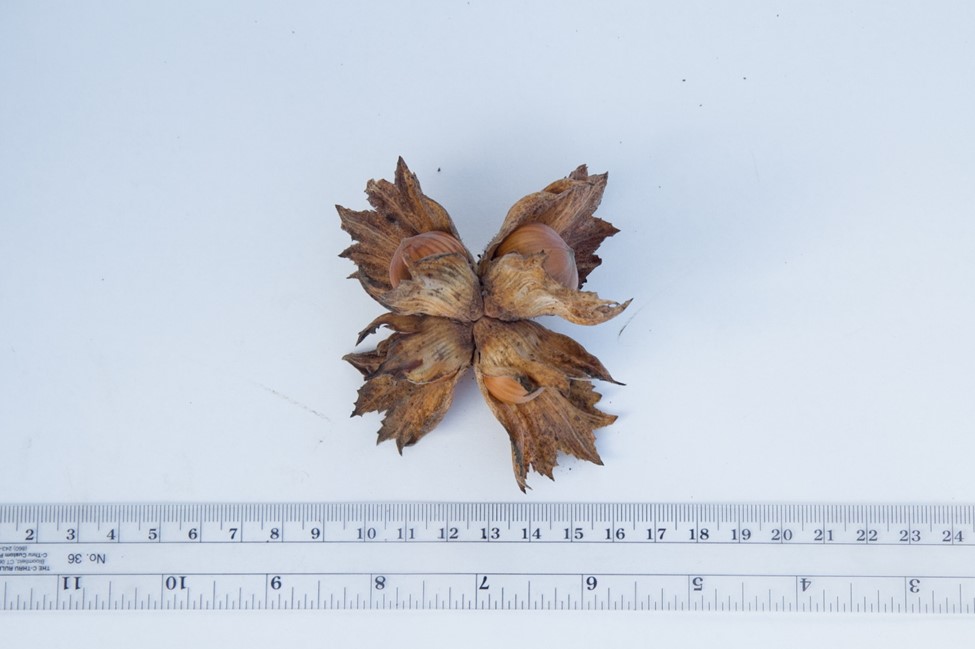Wepster
| Denomination: | 'Wepster' |
|---|---|
| Botanical Name: | Corylus avellana |
| Applicant/Holder: |
Oregon State University Office of Commercialization and Corporate Development 312 Kerr Administration Building Corvallis, Oregon 97331-2140 United States of America |
| Breeder: |
Shawn A. Mehlenbacher, Oregon State University, Corvallis, United States of America David C. Smith, Oregon State University, Corvallis, United States of America Rebecca L. McCluskey, Oregon State University, Corvallis, United States of America |
| Agent in Canada: |
Cassan Maclean IP Agency Inc. 190 O'Connor St., Suite 710 Ottawa, Ontario K2P 2R3 Canada Tel: 613-238-6404 x 240 |
| Application Date: | 2018-05-11 |
| Provisional Protection:: | 2018-05-11 |
| Application Number: | 18-9480 |
Variety Description
Variety used for comparison: 'Gironell'
Summary: The plant of 'Wepster' has medium strength vigour while that of 'Gironell' has strong vigour. The plant of 'Wepster' has strong to very strong suckering while that of 'Gironell' has weak suckering. The leaf bud of 'Wepster' is globular and red while that of 'Gironell' is ovoid and reddish green. The time of leaf bud burst is mid-season for 'Wepster' whereas it is early for that of 'Gironell'. The male inflorescence of 'Wepster' is pink brown while that of 'Gironell' is green. The stigma of 'Wepster' is purple red whereas that of 'Gironell' is red. The time of flowering of the male inflorescence of 'Wepster' is very late whereas it is late for 'Gironell'. The time of flowering of the female inflorescence of 'Wepster' is mid to late season whereas it is mid-season for 'Gironell'. The female and male flowering times for 'Wepster' are synchronous whereas the female flowering time is later than the male flowering time for 'Gironell'. The leaf blade of 'Wepster' is circular whereas that of 'Gironell' is elliptic. The involucre of 'Wepster' has a thin to medium thickness callus at the base, is constricted and has weak to medium indentations that have weak to medium degree of serrations whereas the involucre of 'Gironell' has a medium thickness callus at the base, is not constricted and has strong indentations that have a strong degree of serrations. The fruit cluster of 'Wepster' has predominantly one to two fruits whereas that of 'Gironell' has more than four fruits. The fruit of 'Wepster' is small, with an obtuse shaped top with weak pubescence, strongly prominent apex, and with a small, planar basal scar whereas the fruit of 'Gironell' is medium sized, with flat shaped top with a medium degree of pubescence, slight to medium prominent apex, and with a medium sized, convex basal scar. The kernel of 'Wepster' is small to medium size with a lateral groove and with skin that appears medium corky whereas that of 'Gironell' is medium size with no lateral groove and with skin that appears not corky or very slightly corky to slightly corky. The internal cavity of the kernel of 'Wepster' is absent or very small whereas that of 'Gironell' is medium sized. By weight, the percentage of kernel relative to the fruit is low to medium for 'Wepster' whereas it is very low to low for that of 'Gironell'. The time of ripening of 'Wepster' is mid to late season while 'Gironell' is mid-season.
Description:
PLANT: medium vigour, spreading growth habit, medium density of shoots, strong to very strong suckering
ONE-YEAR-OLD SHOOT: medium thickness, weak pubescence, strong density of lenticels
LEAF BUD: globular shape, red, burst occurs mid-season
MALE INFLORESCENCE: medium length, pink brown
STIGMA: purple red
TIME OF FLOWERING: very late for male flowers, mid to late season for female flowers
LEAF BLADE: circular, medium size, weak pubescence on lower side, leaf fall occurs late
PETIOLE: medium length, medium density pubescence
INVOLUCRE: constriction present, longer than fruit length, weak to medium indentations, weak to medium serration of indentations, thin to medium callus at base, weak density of pubescence, bracts jointed on one sides
FRUIT CLUSTER: predominantly one to two fruits
FRUIT: small, globular, circular in cross-section, greenish yellow, many stripes on shell, obtuse apex, strong prominenceof apex, small pistil scar, weak pubescence of top, small basal scar, basal scar is planar, no double kernels, absent or very weak adherence of involucre after fruit fall
KERNEL: small to medium size, globular, elliptical in cross-section, obtuse apex, rounded base, lateral groove present, medium degree of corkiness of skin, absent or very small internal cavity, low to medium percentage by weight of kernel relative to fruit
TIME OF RIPENING: mid-season to late
Origin & Breeding History: 'Wepster' (experimental designation OSU 894.030) originated from a controlled cross between 'Tonda Pacifica' and 'OSU 440.005' conducted in Corvallis, Oregon, U.S.A. in 1997. Seeds from this cross were planted in 1998. 'Wepster' was finally selected in 2013 in Corvallis, Oregon, U.S.A. based on disease resistance, yield, fruit quality and harvesting factors. Asexual reproduction by root suckers was initiated in Corvallis, Oregon, U.S.A. in 2004.
Tests & Trials: The detailed description of 'Wepster' is based on the UPOV report of Technical Examination, reference number 2018/0218, purchased from The Community Plant Variety Office (CPVO), Angers, France. The trial was conducted by the Spanish Plant Variety Office (OEVV), at the Institute of Agrifood Research and Technology in Mas Bové, Spain from 2019 to 2023.
Click on image for larger view

Hazelnut: 'Wepster'
Click on image for larger view

Hazelnut: 'Wepster'
- Date modified: